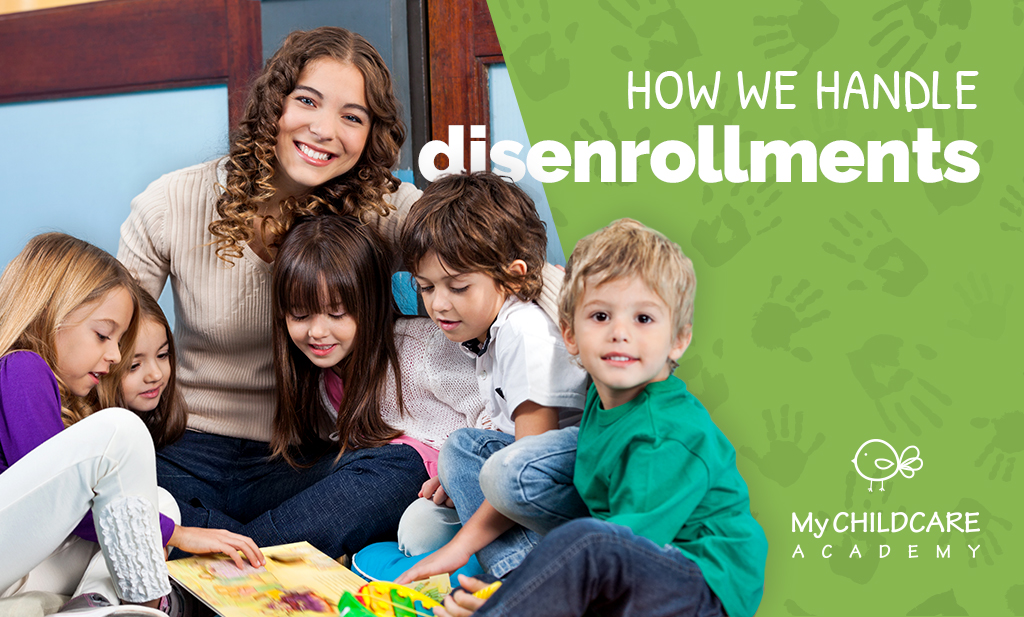
How We Handle Disenrollments
The everyday life of a teacher and child care provider is as stress-free and easygoing as a perfect sunny day at the beach, said no teacher or child care provider ever. As much as childcare providers take great pride in their work, they come to work knowing that children will have hard days. And that’s okay! My Childcare Academy’s teachers and directors are incredibly well-equipped, supported, and trained on how to handle these inevitable situations.

Where Do Challenging Behaviors Come From?
Challenging behaviors are often a result of a child’s inability to identify and cope with difficult situations in their life. These behaviors can stem from a myriad of life events, such as:
- Irregular sleep schedules
- Changes in the home
- Communication barriers
- Dietary challenges
- And so much more!
As teachers and directors, we love to rise to the challenge for these children and their families and be the hero they need. However, there are rare circumstances where we have to consider the possibility of helping families find better care and solutions for themselves and their children. The ugly word for that is often called ‘disenrollment’ and we hate it, a lot.
Our Values
Here, you’ll find the steps we take to avoid that outcome and find a solution that will help these children thrive! Working closely with children, there are going to be times when difficult behaviors come up. Because we teach values, such as:
- Respecting others
- Emotional support
- Compromise
- Boundaries
We take it seriously when a child is struggling to treat others or themselves kindly. When a child consistently struggles to show kindness to their friends and teachers, despite all of our best efforts, that is when we have to consider disenrollment.
What is Disenrollment?
Disenrollment means that a child is no longer enrolled with us and won’t be able to return or, in some instances, they can be re-enrolled with conditions. These conditions vary from child to child and will require full support from the parents/guardians.
Disenrollments are one the most difficult parts of running a childcare center. When a child first enrolls, we hope that we are the right place for them and their family. For the majority of the children in our care, we are. But in those rare instances of disenrollment, we understand that we might not be the right place for that child. That is why we do everything we can to help parents find the right care for their children.
Why We Would Have to Consider Disenrollments
As difficult as disenrollments are for staff, families, and children, there are times that it becomes the necessary next step. Disenrollment happens when behavioral issues become too great and put the well-being of other children, themselves, or teachers at risk.
At this point, it usually means the child is struggling and we are not able to meet one or many of their needs. Each child is different and their emotional requirements are different as well. Some children do fine in large groups, while others strive in smaller groups, or even with one on one social interactions.
We understand that kids have big emotions, and there are instances where those emotions and feelings are happening because of changes in their lives. That is why we always try to work with the kids and parents before considering disenrollment. Usually, with parent support, we can find a way to work with the child that sets them up for success and they end up thriving. However, if we have met with the parents multiple times and have tried every approach within our training and the behavior continues, this is when we have to take that next step.

What Warnings Are Given Before Disenrollment
Warnings depend on the situation and repeated behaviors. We send reports home and notify parents of any behaviors that we see as a major disturbance to running our classrooms successfully. Before disenrolling, we will try different solutions to see if it helps with behavioral issues.
For example, if a child is having a hard time following a teacher’s instructions, we’ll try sensory objects to help them focus. If a child seems easily upset, we have earphones and sunglasses in the classrooms that can sometimes help the child feel less overwhelmed by the noise or brightness of a classroom. Overstimulation is a major issue for some children. In the case of violence, we’ll remove them from the other kids and try mindfulness cards and calm-down strategies.
Emotions can be confusing for a child, some emotions they are feeling for the first time. We use emotion charts to help teach the children about emotions and self-awareness. We teach the children that it’s okay to feel angry or sad and give them helpful and healthy ways to express what they are feeling. An example of something we will say to the children is, “It’s okay that you feel angry. I would be angry too if my tower was knocked down. It’s not okay to hurt our friends when we are angry. How could we have handled that differently?” Or, “I see that you are angry. Tell me what happened.” Some children need more guidance, whereas others just need to feel understood and heard.
Our Disenrollment Process
Disenrollments are something we take very seriously. When disenrolling a child, it usually doesn’t come as a surprise to parents as we keep in regular communication with updates and occasional reports that we require parents to sign. After warnings are sent out, the next steps to disenrollment are as follows:
- Teacher Meetings: The first step is to set up meetings with all classroom teachers and center directors to discuss what difficulties we are seeing and what steps we can take to help.
- Parent Involvement: Next, we involve the parents and give them different ways they can try to help from home and ask for suggestions on what we can do to better support the child while at school.
- Continued Watch: After the parent meeting, we keep a close eye on the child and let the parents know about their struggles and what is working. This is an adjustment period where we can tweak the plan until we find the right method for each child.
- Continued Meetings: If we haven’t found a solution for these challenging behaviors, we then schedule another meeting to discuss disenrollment and give the parents ideas on possible solutions and what we think would best suit the child for future success.
Disenrollment comes at a time when the classroom as a whole has to be considered. We never want any child or parent to feel as if they don’t have a place in which they can thrive. That is why we will always provide additional ideas on how to help the child, even after disenrollment. There is always something that can be done to help children grow and thrive, and it’s okay if it’s not with us.
My Childcare Academy is Here to Help
While disenrollments are our least favorite thing to do, we always want to do what is in the best interest of the child. Disenrollments are the last-case scenario and even though we may not be the right place for your child, many great solutions can meet their particular needs. If you have any questions or concerns, please don’t hesitate to reach out. We are here to help support you and your child.
